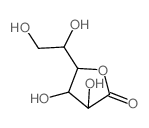The terminal step in vitamin C biosynthesis in Trypanosoma cruzi is mediated by a FMN-dependent galactonolactone oxidase.
Flora J Logan, Martin C Taylor, Shane R Wilkinson, Harparkash Kaur, John M Kelly
Index: Biochem. J. 407(3) , 419-26, (2007)
Full Text: HTML
Abstract
Humans lack the ability to synthesize vitamin C (ascorbate) due to the absence of gulonolactone oxidase, the last enzyme in the biosynthetic pathway in most other mammals. The corresponding oxidoreductase in trypanosomes therefore represents a target that may be therapeutically exploitable. This is reinforced by our observation that Trypanosoma cruzi, the causative agent of Chagas' disease, lacks the capacity to scavenge ascorbate from its environment and is therefore dependent on biosynthesis to maintain intracellular levels of this vitamin. Here, we show that T. cruzi galactonolactone oxidase (TcGAL) can utilize both L-galactono-gamma-lactone and D-arabinono-gamma-lactone as substrates for synthesis of vitamin C, in reactions that obey Michaelis-Menten kinetics. It is >20-fold more active than the analogous enzyme from the African trypanosome Trypanosoma brucei. FMN is an essential cofactor for enzyme activity and binds to TcGAL non-covalently. In other flavoproteins, a histidine residue located within the N-terminal flavin-binding motif has been shown to be crucial for cofactor binding. Using site-directed mutagenesis, we show that the corresponding residue in TcGAL (Lys-55) is not essential for this interaction. In contrast, we find that histidine and tryptophan residues (His-447 and Trp-448), localized within a C-terminal motif (HWXK) that is a feature of ascorbate-synthesizing enzymes, are necessary for the FMN association. The conserved lysine residue within this motif (Lys-450) is not required for cofactor binding, but its replacement by glycine renders the protein completely inactive.
Related Compounds
| Structure | Name/CAS No. | Molecular Formula | Articles |
|---|---|---|---|
 |
L-galactono-1,4-lactone
CAS:1668-08-2 |
C6H10O6 |
|
The biosynthesis of erythroascorbate in Saccharomyces cerevi...
2000-01-15 [Free Radic. Biol. Med. 28(2) , 183-92, (2000)] |
|
De novo asymmetric syntheses of C-4-substituted sugars via a...
2006-07-24 [Carbohydr. Res. 341(10) , 1505-21, (2006)] |
|
Cellular ascorbic acid regulates the activity of major perox...
2007-01-01 [Plant Physiol. Biochem. 45(3-4) , 188-98, (2007)] |
|
Galactone-γ-lactone-dependent ascorbate biosynthesis alters ...
2012-07-01 [Plant Biol. (Stuttg.) 14(4) , 652-8, (2012)] |
|
Hydroponically cultivated radish fed L-galactono-1,4-lactone...
2002-01-01 [Planta 214(3) , 383-91, (2002)] |